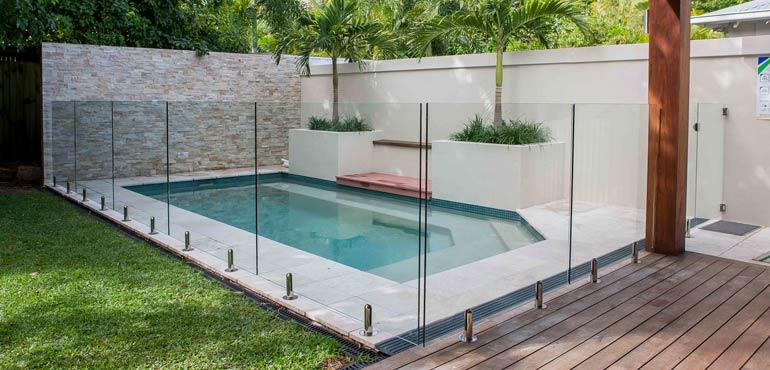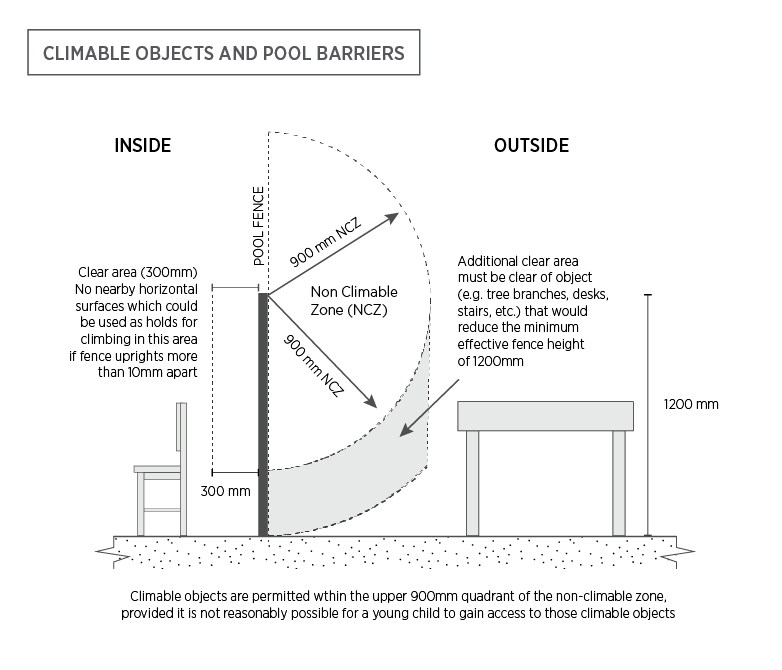
- Home
- Your property
- Non-climbable zones
Non-climbable zones
An important part of building pool fences is making non-climbable zones, both on the fence and around the fence.
The pool safety standard requires fences to have continuous 900mm non-climbable zones, areas that cannot be climbed by a small child. These rules are detailed under pool fences.
The standard also requires pool owners to create a clear area on the inside the pool fence immediately next to the external non-climbable zone. This means moving anything that would make the fence easy to climb:
- 900mm away from the outside of the fence
- 300mm away from the inside.

Climbable objects
Look around your pool fence for climbable objects such as:
- BBQs and outdoor furniture
- trees, shrubs or overhanging branches
- pot plants
- garden features such as rockeries or raised garden beds
- garden edging
- steps, ledges and stairs
- toys, including trampolines
- air-conditioning units
- taps and other plumbing fixtures and pipework
- outdoor umbrellas
- deck ledges
- window sills or climbable security screens on windows or security doors.
You must remove these objects or move them at least:
- 300mm from the inside of the fence
- 900mm from the outside of the fence.
If you cannot make a non-climbable zone on the outside of your fence you can build your fence to a minimum 1800mm in height and rely on an internal non-climbable zone.
Intersecting fences
If your pool fence has a corner with another fence you must check both barriers conform to the safety rules to make sure a child can't climb into the pool area. You might need to adapt any existing fences to make sure there are no footholds or hand holds within the non-climbable zone.
This is often a problem on timber paling fences when horizontal rails on each fence join without the correct distance between the two. Fit a timber wedge to each rail for at least 900mm from the corner, both inside and outside the fence.
If the rails are on your neighbour's side you might need to:
- increase the height of your fence to at least 1800mm
- have no climbable objects within the upper 900mm on the inside of your fence.
If you cannot make an outside non-climbable zone
If you cannot make an outside non-climbable zone, you have the option to build your fence at least 1800mm high and have the non-climbable zone on the inside of the fence.
This could be useful for a boundary fence, for example, where it is difficult to make the non-climbable zone outside and you have no control of what your neighbour may place against their side of the fence.
To do this you must:
- have a 900mm non-climbable zone on the inside of the fence
- measure the non-climbable zone from the top of the fence
- ensure the inside height of the fence is 1800mm, with nothing at the bottom (such as a deck) that would reduce the height.
Tips for dealing with climbable objects
If you can't move a climbable object you can make it non-climbable by adding:
- flat polycarbonate sheeting or similar to shield the climbable object
- vertical palings
- a fillet with an angle of 60 degrees or more.
Vegetation
Trim any branches within 900mm of your pool fence. Remember, branches may grow back quickly so it may be best to consider removing the plant entirely.
If branches overhang from a neighbouring property, you may need to negotiate with your neighbour to remove them.
Trim any other climbable vegetation away from the fence, both on the inside and outside.
Garden beds
Your pool fence must be at least 1200mm above the finished ground level.
To do this you might need to:
- remove raised garden beds if they are within 900mm of the fence
- reduce the height of surrounding ground levels and garden beds
- raise the fence height.
Build your fence on solid ground
Make sure the surface under a fence is solid. Sand or garden mulch can be moved easily by young children to create a gap greater than 100mm that they can crawl under to gain access to the pool.